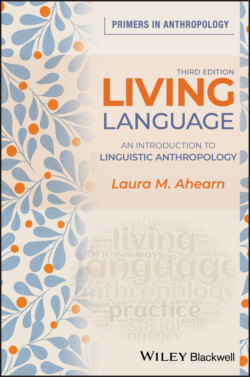Читать книгу Living Language - Laura M. Ahearn - Страница 4
Table of Contents
Оглавление1 Cover
2 Title page
3 Copyright
4 Table of Contents
5 List of Figures
6 List of Tables
7 Preface
8 Acknowledgments
9 Part I Language: Some Basic Questions1 The Socially Charged Life of LanguageSo, What Do You Need to Know in Order to “Know” a Language?Examples of Linguistic DiversityExamples of Diversity in Research Topics in Linguistic AnthropologyKeith BassoMarjorie Harness GoodwinBonnie UrciuoliAlessandro DurantiKathryn A. WoolardJames M. WilceKey Terms in Linguistic AnthropologyMultifunctionalityLanguage IdeologiesPracticeIndexicalityThe Inseparability of Language, Culture, and Social Relations2 Gestures, Sign Languages, and MultimodalityBakhtin’s Double-Voiced DiscourseGoffman’s Participation Framework and Production FormatSpeech and the Analysis of ConversationGestures and Other Forms of Embodied CommunicationSign LanguagesPoetry, Whistled Languages, Song, and Images3 The Research Process in Linguistic AnthropologyWhat Kinds of Research Questions Do Linguistic Anthropologists Formulate?What Kinds of Data Do Linguistic Anthropologists Collect, and with What Methods?Participant ObservationInterviewsSurveys and QuestionnairesNaturally Occurring ConversationsExperimental MethodsMatched Guise TestsWritten TextsHow Do Linguistic Anthropologists Analyze Their Data?What Products Do Linguistic Anthropologists Generate from their Research?What Sorts of Ethical Issues Do Linguistic Anthropologists Face?4 Language Acquisition and SocializationLanguage Acquisition and the Socialization ProcessGaps in the “Language Gap” ApproachLanguage Socialization in Bilingual or Multilingual ContextsLanguage Socialization throughout the LifespanConclusion5 Language, Thought, and CultureA Hundred Years of Linguistic RelativityThe Sapir–Whorf HypothesisInvestigating the Effects of Language on ThoughtLanguage-in-GeneralLinguistic StructuresColorSpaceTimeLanguage UseConclusion
10 Part II Global Communities of Speakers, Hearers, Readers, and Writers6 Global Communities of Multilingual Language UsersDefining “Speech Community”Size and Location of the CommunityWhat Is Shared by the Members of a Speech Community?The Type of Interactions that Speech Community Members HaveAlternatives to the Concept of “Speech Community”Speech AreasSpeech NetworksCommunities of PracticeMultilingual and Transnational Linguistic PracticesDiglossia, Code-Mixing, and Code-SwitchingDiglossiaCode-SwitchingCode-MixingHeteroglossiaConclusion7 Literacy PracticesLiteracy Events vs. Literacy Practices“Autonomous” vs. “Ideological” Approaches to Studying LiteracySome Examples of Situated Literacy ResearchPreschool Literacy Practices in the Southeastern United StatesPema Kumari’s letterLove-letter Writing in NepalInstant Messaging: More like Speech or Writing?8 Online Communities and Internet Linguistic PracticesOnline Literacy PracticesCapitalization, Punctuation, and EmojisOnline Communities, Relationships, and Social MediaWho’s Zoomin’ Who?Online AvatarsSo Close and yet so FarConclusion9 Performance, Performativity, and the Constitution of CommunitiesPerformance Defined in Opposition to CompetencePerformativityPerformance as a Display of Verbal ArtistryEthnographies of Performance and Performativity
11 Part III Language, Power, and Social Differentiation 10 Language and GenderWhat is Gender, and How Does it Relate to Language?Do Men and Women Speak Alike or Differently?Do Women and Men of All Ages and All Ethnic, Racial, and Cultural Backgrounds Share the Same Gendered Differences in Their Language Use?Some Thoughts on Myths and Realities11 Language, Race, and EthnicityDefining Race and EthnicityThe Rule-Governed Nature of African American EnglishInvariant or Habitual “Be”Copula DeletionDouble NegativesThe Reduction of Final ConsonantsPronouncing the Word “Ask” as “Aks”Racist Language and Racism in LanguageLanguage and Racial/Ethnic IdentitiesConclusion12 Language Endangerment and RevitalizationEnumerating the Crisis: How Many Endangered Languages are There?What Dies When a Language Dies?Why Do Languages Die?Can Endangered Languages Be Saved?Conclusion13 Conclusion: Language, Power, and AgencyWhat Is Power?HegemonyFoucault’s Power Relations and DiscoursePractice Theory and PowerAgencyThe Grammatical Encoding of AgencyTalk About Agency: Meta-Agentive DiscoursePower and Agency In/through/by/of Language
12 Notes
13 References
14 Index
15 End User License Agreement
